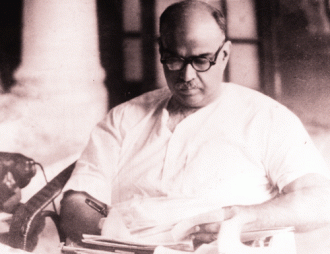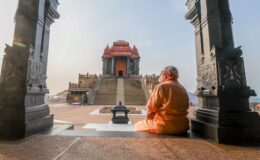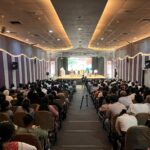INTERVENTIONS THAT SAVED INDIA
- By : Anirban Ganguly
- Category : Articles

Had it not been for Syama Prasad Mookerjee’s interventions, India would have been a different place — its very raison d’être severely challenged and besieged. His sacrifice ensured that the civilisational bonds between this portion of India and the rest were further cemented
Delivering a captivating public address in Thiruvananthapuram on the occasion of Syama Prasad Mookerjee’s martyrdom day on June 23, BJP national president Amit Shah, while discussing Mookerjee’s multifaceted personality, made an interesting observation, he said that Mookerjee made three epochal interventions in the history of modern India that decisively altered the trajectory national events. That Mookerjee could make these three epochal interventions within a short lifespan of about 52 years, argued Shah, was in itself striking and inspiring. Each of these interventions, Shah observed, altered the trajectory of modern India.
The first was his intervention which ruptured Jinnah’s plan of greater Pakistan and the retaining of Calcutta and West Bengal in India as a place where the Bengali Hindus could live and also find refuge after being pushed out of east Pakistan, the second was the formation of the Bharatiya Jana Sangh (BJS) as a nationalist alternative to the faction ridden and increasingly one-tracked Congress, which in the early days after independence, especially after the demise of Sardar Patel, had already begun degenerating into a one-man driven vehicle and the third was Mookerjee’s intervention in Kashmir which eventually ensured that the State remained as an integral part of the Indian Union.
It will be interesting to extrapolate on what would have happened had Mookerjee not initiated these interventions? The first of course is self-evident, the entire Bengal and Punjab would have gone to Pakistan providingjihad a larger area from which to breed and spread the poison. The Bengali Hindus, on the other hand, without a home state, would have to migrate to various parts of the country as a dispossessed and displaced people clinging to the memories of a homeland. The communists and the Trinamool Congress (TMC) would have no space or the luxury to practice their brand of violent and communal politics sans West Bengal.
In Pakistan and east Pakistan and later in Bangladesh, the communist variety of politics has been thrown out and its leaders either liquidated or co-opted within the framework of a vastly different political framework. Proletarianism, dialecticism and class war or secularism had no place in Pakistan, whose formation Indian communists so wholeheartedly supported and facilitated. On the other hand TMC chief Mamata Banerjee, who celebrates the anniversaries of every other Bengali personality and takes to social media to deliver messages, has always been conspicuously silent on Mookerjee’s legacy and contributions. The false fear of alienating a certain section of her vote-bank has always seen her ignore his contribution in the formation of West Bengal. His successful experiment with Fazlul Haq in the formation of the progressive coalition ministry — popularly known as the Syama-Haq ministry — and its success in sidelining the Muslim League in Bengal is deliberately ignored and suppressed.
While Indian communists were actively colluding with their colonial sponsors to sabotage the Quit India movement, Mookerjee, then Finance Minister of Bengal, resigned with this words, “The reign of repression that we have witnessed in India since August last [August 1942] has been directed not only against a so-called subversive movement but against every form of nationalist activities, calculated to mobilise the will-powers of Indians to throw off a foreign rule that they intensely dislike.” Mookerjee exerted himself to the outmost to see that the repression unleashed was reversed and when he failed to do that he resigned pointing out that provincial autonomy under the British was indeed a “farce.” But we digress; let us come back to the question, had Mookerjee not made these interventions…
Mookerjee’s second intervention was when he created BJS. Realising early the unilateralism of the Congress and the dictatorial tendencies of its leadership in the absence of a viable alternative, Mookerjee launched this alternate political narrative. “Political independence becomes meaningful only if it is accompanied by realisation of the National Self”, pointed out the first manifesto of BJS, that Mookerjee drafted, “and only this realisation of the National Self would help open up the mainsprings of people’s energies so that the nation could overcome the feeling of dependence and defeatism, and experience the glow of freedom.” It was this quest for the “National Self” that led him to create this alternative.
It also argued that [India] is beset with a horde of problems, internal and external, old and new, which instead of nearing solution after independence are daily getting aggravated. Its common people are being ground down under the weight of economic distress, social security and political repression. Its production is falling, black-marketing and profiteering are rampant and charges of corruption and favouritism against the administration, which is top heavy, are being openly made. As a result of all this an atmosphere of general demoralisation and frustration has developed in every sphere.
This state-of-affairs, if allowed to grow unchecked, would spell disaster for the country. “The mistaken policies and ‘Abharatiya’ and unrealistic approach to the national problems by the party in power”, it observed, “is primarily responsible for this state-of-affairs in the country. In their anxiety to make Bharat a carbon-copy of the West, they have ignored and neglected the best in Bharatiya life and ideals. They have failed to harness the enthusiasm created by freedom to the task of realisation of the great potentialities of the country.” Had Mookerjee not intervened by creating BJS, Congress unilateralism would have dominated; it would have pushed India into a one-party or a one family rule and Indian democracy would have been poorer, with less or little options, and with democratic voices facing a stifling embargo put up by a spirit of political intolerance.
Mookerjee’s last intervention was in the affairs of Jammu & Kashmir which, he argued, had to be more completely integrated with India in order to ensure India’s well-being and its security and integrity. The sovereignty of the Indian Parliament and the Indian Constitution, Mookerjee felt, had to be paramount and the benefit of the Constitution had to reach all citizens. Had Mookerjee not made this final — and for him fatal because he never emerged out it alive — intervention, the entire State of Jammu & Kashmir would have perhaps gone into the control of those forces who wish to see India fragmented and in flames.
His intervention and sacrifice ensured that the civilisational bonds between this portion of India and the rest were further strengthened and cemented. The last was indeed a civilisational intervention that saved for India one of her most sacred and strategic portions. For preserving and perpetuating India’s unity and freedom even death was acceptable, as he once presciently observed, “We must live and die for India and her liberty. This an article of faith with us and it admits of no compromise.”
Had Mookerjee not made these interventions, India would have been different place — its very raison d’être severely challenged and besieged. His death anniversary on June 23 and his birth anniversary on July 6 thus, offer an ideal occasion for reflecting on these. Such a reflection may offer great lessons and insights, especially at a time when calling for India’s destruction and disintegration is de rigueur for some…

















